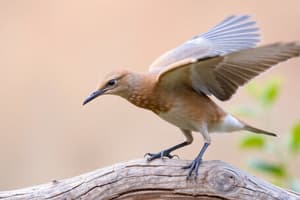Podcast
Questions and Answers
What is one reason why birds migrate?
What is one reason why birds migrate?
- To build a nest
- To escape harsh weather (correct)
- To find a mate
- To learn new songs
What is a characteristic of polygynous bird species?
What is a characteristic of polygynous bird species?
- One male mates with multiple females (correct)
- One female mates with multiple males
- Mates are chosen randomly
- Both males and females mate with multiple partners
What is a benefit of flocking behavior in birds?
What is a benefit of flocking behavior in birds?
- It provides protection from predators (correct)
- It reduces foraging success
- It leads to territorial behavior
- It increases competition for resources
How do some birds communicate with each other?
How do some birds communicate with each other?
What is a unique feature of the lyrebird's communication?
What is a unique feature of the lyrebird's communication?
What is an example of a tool used by birds to obtain food?
What is an example of a tool used by birds to obtain food?
What influences the foraging behavior of some bird species?
What influences the foraging behavior of some bird species?
What is a benefit of cooperative breeding in birds?
What is a benefit of cooperative breeding in birds?
Flashcards are hidden until you start studying
Study Notes
Migration
- Many bird species migrate to find food, escape harsh weather, and breed
- Some birds migrate alone, while others travel in large flocks
- Migration patterns can be influenced by celestial navigation, magnetic fields, and visual cues
- Some birds make incredible journeys, such as the Arctic tern, which migrates from the Arctic to the Antarctic and back again each year
Mating and Courtship
- Birds have unique courtship displays to attract mates, such as bright plumage, song, and dance
- Some species are monogamous, while others are polygynous (one male, multiple females)
- Males often engage in territorial behavior to defend their mating grounds
- Courtship displays can be elaborate, such as the peacock's famous tail display
Social Behavior
- Many bird species are social, living in flocks or colonies
- Flocking behavior provides protection from predators and improves foraging success
- Some species are known for their complex social structures, such as the hierarchical society of peacocks
- Birds also engage in cooperative breeding, where multiple individuals help raise young
Communication
- Birds communicate through a variety of methods, including vocalizations, visual displays, and chemical signals
- Songbirds are known for their complex songs, which serve as territorial markers and attract mates
- Some species have unique forms of communication, such as the mimicry of the lyrebird
- Birds also use body language to convey information, such as threat displays or courtship postures
Foraging and Feeding
- Birds have evolved unique foraging strategies to obtain food, such as filter-feeding, seed-eating, and insect-hunting
- Some species are specialized to exploit specific food sources, such as nectar-feeding hummingbirds
- Birds often use tools to obtain food, such as the woodpecker's use of its beak to extract insects from trees
- Foraging behavior can be influenced by social learning, where birds learn from others in their group.
Migration
- Birds migrate primarily to access food, avoid extreme weather, and for breeding purposes.
- Migration can occur solo or in large, organized flocks depending on the species.
- Navigation during migration relies on celestial cues, magnetic fields, and visual landmarks.
- The Arctic tern undergoes one of the longest migrations, traveling annually from the Arctic to the Antarctic and back.
Mating and Courtship
- Courtship displays among birds include vibrant plumage, melodious songs, and dynamic dances to attract partners.
- Various mating systems exist, with some birds forming monogamous pairs while others exhibit polygyny.
- Males frequently display territorial behaviors to secure and defend their breeding territories.
- The peacock is renowned for its extravagant tail displays, a hallmark of their courtship rituals.
Social Behavior
- Many bird species exhibit social behavior, often forming flocks or colonies for safety and efficiency.
- Flocking provides collective protection against predators and enhances foraging opportunities.
- Some birds, like peacocks, have intricate social hierarchies that dictate group dynamics.
- Cooperative breeding occurs in certain species, allowing multiple adults to assist in rearing fledglings.
Communication
- Birds utilize diverse communication methods such as vocal sounds, visual signals, and sometimes chemical cues.
- Songbirds are particularly noted for their elaborate songs, which serve both as territorial markers and mate attractors.
- The lyrebird showcases unique communication through mimicry, imitating other sounds it encounters in its environment.
- Body language plays a crucial role in avian communication, with specific postures indicating threats or courtship intentions.
Foraging and Feeding
- Birds possess specialized foraging techniques to acquire food, including filter-feeding, seed consumption, and insect hunting.
- Certain species, like hummingbirds, have adapted to exploit niche food resources such as nectar.
- Some birds, like woodpeckers, utilize tools (in this case, their beaks) to extract insects hidden within tree bark.
- Social learning influences foraging behavior, allowing individuals to observe and imitate successful feeding strategies from their peers.
Studying That Suits You
Use AI to generate personalized quizzes and flashcards to suit your learning preferences.




